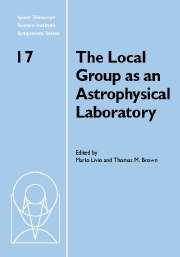 The Local Group as an Astrophysical Laboratory
The Local Group as an Astrophysical Laboratory Published online by Cambridge University Press: 12 May 2010
I present the preliminary results of a program to measure the star formation history in the halo of the Andromeda galaxy. Using the Advanced Camera for Surveys (ACS) on the Hubble Space Telescope, we obtained the deepest optical images of the sky to date, in a field on the southeast minor axis of Andromeda, 51′ (11 kpc) from the nucleus. The resulting color-magnitude diagram (CMD) contains approximately 300,000 stars and extends more than 1.5 mag below the main sequence turnoff, with 50% completeness at V = 30.7 mag. We interpret this CMD using comparisons to ACS observations of five Galactic globular clusters through the same filters, and through χ2-fitting to a finely-spaced grid of calibrated stellar population models. We find evidence for a major (∼30%) intermediate-age (6–8 Gyr) metal-rich ([Fe/H]> −0.5) population in the Andromeda halo, along with a significant old metal-poor population akin to that in the Milky Way halo. The large spread in ages suggests that the Andromeda halo formed as a result of a more violent merging history than that in our own Milky Way.
Introduction
One of the primary quests of observational astronomy is understanding the formation history of galaxies. An impediment to this research is the relative paucity of galaxies in the Local Group, which contains no giant ellipticals, and only two giant spirals-our own Milky Way and Andromeda. Fortunately, Andromeda (M31, NGC 224) is well situated for studying the formation of giant spiral halos, due to its proximity (770 kpc; Freedman & Madore 1990), small foreground reddening (EB-V = 0.08 mag; Schlegel, Finkbeiner, & Davis 1990), and low inclination (i ≍ 12.50°; de Vaucouleurs 1958).
To save this book to your Kindle, first ensure [email protected] is added to your Approved Personal Document E-mail List under your Personal Document Settings on the Manage Your Content and Devices page of your Amazon account. Then enter the ‘name’ part of your Kindle email address below. Find out more about saving to your Kindle.
Note you can select to save to either the @free.kindle.com or @kindle.com variations. ‘@free.kindle.com’ emails are free but can only be saved to your device when it is connected to wi-fi. ‘@kindle.com’ emails can be delivered even when you are not connected to wi-fi, but note that service fees apply.
Find out more about the Kindle Personal Document Service.
To save content items to your account, please confirm that you agree to abide by our usage policies. If this is the first time you use this feature, you will be asked to authorise Cambridge Core to connect with your account. Find out more about saving content to Dropbox.
To save content items to your account, please confirm that you agree to abide by our usage policies. If this is the first time you use this feature, you will be asked to authorise Cambridge Core to connect with your account. Find out more about saving content to Google Drive.